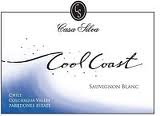|
|
 |

Casa Silva, Colchagua Valley (Chile) Paredones Estate “Cool Coast” Sauvignon Blanc 2011 (Vin DiVino, $23): If you’ve been drinking wine for a decade or two, you might remember the typical Chilean Sauvignon Blanc of the old days, a high-acid, fairly thin wine nearly devoid of flavor. In this century, Sauvignon Blanc from Chile has improved big time, and is now one of Chile’s top categories of wine in my opinion. What changed? Chilean winemakers have gone west, planting cool-climate varieties such as Sauvignon Blanc in coastal vineyard areas -- Casablanca, San Antonio, Leyda, Limari…and now Paredones.
Until I tasted Casa Silva’s Cool Coast Sauvignon Blanc, I was unfamiliar with Paredones. It’s not an official wine region but a part of the  Colchagua Valley, which itself is part of the Rapel region, in Chile’s Central Valley. However, there’s nothing “central” about Paredones: This particular vineyard is only five miles from the Pacific Ocean. The climate is cool in summer, the temperature never rising above 79°F, and mild in winter, with temperatures hovering around 50°F. Morning fog is common, and humidity is a fact of life, but sea breezes mitigate the negative effects of humidity for grape growers. Sauvignon Blanc ripens slowly here, enabling flavor development; Casa Silva harvests the grapes five weeks later than in its more interior vineyards. Colchagua Valley, which itself is part of the Rapel region, in Chile’s Central Valley. However, there’s nothing “central” about Paredones: This particular vineyard is only five miles from the Pacific Ocean. The climate is cool in summer, the temperature never rising above 79°F, and mild in winter, with temperatures hovering around 50°F. Morning fog is common, and humidity is a fact of life, but sea breezes mitigate the negative effects of humidity for grape growers. Sauvignon Blanc ripens slowly here, enabling flavor development; Casa Silva harvests the grapes five weeks later than in its more interior vineyards.
Casa Silva is a vineyard operation founded by a French immigrant in 1892 that began bottling its own wine only in 1997. Headquartered farther inland in the Colchagua Valley, the winery is known for its Carmenère wines, for its century-old vines in the Angostura district of Colchagua, and for its red vine plantings on the foothills of the Andes nountains. But it has planted 49 acres of vines in coastal Paredones. The first vintage of Cool Coast Sauvignon was 2009.
The 2011 Cool Coast Sauvignon Blanc is a dry but very fruity, un-oaked Sauvignon Blanc. The piercing aroma strikes me as the epitome of freshness, with leafy notes and a hint of fresh pineapple. In your mouth, the wine has rich texture that rounds out its very high acidity, and it brims with flavor: pineapple, mango, orange and a mineral undertone. Some of this fruitiness suggests candied fruit, probably a result of fermentation esters that might still be present in this young wine; the wine’s flavors will most likely evolve over the next few months. The wine shows depth on the mid-palate and good length, with a finish that refrains the fruity flavors in your mouth.
Winemaking was straightforward, with no skin contact, and a very cool fermentation (55°F) in stainless steel tanks. The wine is 13 percent alcohol.
This wine calls for very flavorful, fresh foods. Salads with fruit, arugula salad, fish dishes with fresh-herbs, ceviche, raw fish and seafood, gazpacho, pasta with pesto sauce -- all these will be terrific with this wine. Because this wine is very flavorful, it’s also delicious all by itself.
89 Points
|
 |
|